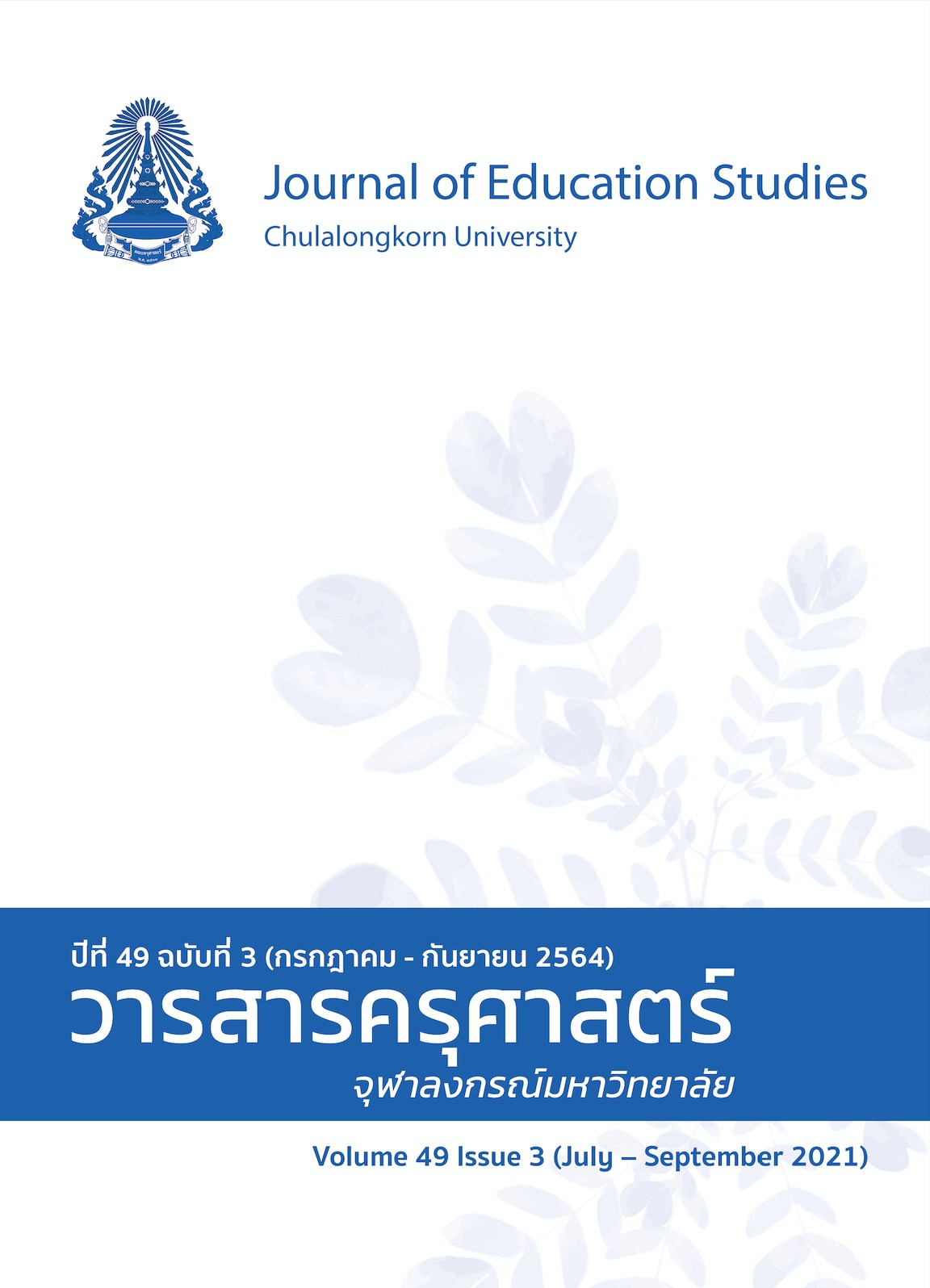กรอบแนวคิดการจัดการความหลากหลายทางวัฒนธรรมในโรงเรียนขนาดใหญ่พิเศษ
DOI:
https://doi.org/10.14456/educu.2021.44คำสำคัญ:
ความหลากหลายทางวัฒนธรรม, การจัดการความหลากหลายทางวัฒนธรรม, กรอบแนวคิดบทคัดย่อ
การวิจัยครั้งนี้มีวัตถุประสงค์เพื่อศึกษาและประเมินกรอบแนวคิดของการจัดการความหลากหลายทางวัฒนธรรมในโรงเรียนขนาดใหญ่พิเศษ เป็นการวิจัยผสานวิธี ดำเนินการ 2 ขั้นตอน คือ 1) ศึกษาเอกสารเกี่ยวกับการจัดการความหลากหลายทางวัฒนธรรม จำนวน 15 แหล่ง เพื่อสังเคราะห์กรอบแนวคิดของการจัดการความหลากหลายทางวัฒนธรรมที่ประกอบด้วยองค์ประกอบและตัวบ่งชี้จากแนวคิดและงานวิจัยที่เกี่ยวข้อง และ 2) ประเมินกรอบแนวคิดการจัดการความหลากหลายทางวัฒนธรรมตามกรอบที่ได้สังเคราะห์จากเอกสารโดยผู้ทรงคุณวุฒิจำนวน 5 คน เครื่องมือที่ใช้ในการวิจัย ได้แก่ แบบประเมินเป็นแบบตรวจสอบรายการและแบบปลายเปิดเพื่อเสนอแนะ โดยวิเคราะห์หาค่าดัชนีความสอดคล้อง (Index of Item Objective Congruence: IOC) ผลการวิจัยพบว่า 1) กรอบแนวคิดของการจัดการความหลากหลายทางวัฒนธรรมในโรงเรียนขนาดใหญ่พิเศษ มี 5 องค์ประกอบหลัก ได้แก่ (1) การฝึกอบรมทางวัฒนธรรม มี 3 ตัวบ่งชี้ (2) การจัดระบบพี่เลี้ยงและให้คำปรึกษา มี 3 ตัวบ่งชี้ (3) ภาวะผู้นำเชิงวัฒนธรรม มี 3 ตัวบ่งชี้ (4) การสื่อสารระหว่างวัฒนธรรม มี 4 ตัวบ่งชี้ และ (5) การจัดวางบุคลากรที่หลากหลาย มี 3 ตัวบ่งชี้ และ 2) ผลการประเมินกรอบแนวคิดของการจัดการความหลากหลายทางวัฒนธรรมในโรงเรียนขนาดใหญ่พิเศษมีค่าดัชนีความสอดคล้อง (IOC) อยู่ระหว่าง 0.80 – 1.00 ซึ่งผ่านเกณฑ์ทุกองค์ประกอบและตัวบ่งชี้
เอกสารอ้างอิง
กฤติน กุลเพ็ง. (2555). กลยุทธ์การสรรหาบุคลากร. พิมพ์ดีการพิมพ์.
กฤษณะโชติ บัวหล้า. (2560). การจัดการความหลากหลายทางวัฒนธรรมด้านทรัพยากรบุคคลของ “องค์การเอกชนใน อุตสาหกรรมบริการ”. วารสารพฤติกรรมศาสตร์เพื่อการพัฒนา, 9(1), 1-17.
เกษราภรณ์ สุตตาพงค์, ธามน รัตนจินดา, และ ณัฐยา ยวงใย. (2563). กลยุทธ์การสื่อสารเพื่อจัดการความหลากหลายทางวัฒนธรรมในองค์กรยุคประเทศไทย 4.0. วารสารนักบริหาร, 40(1), 125-139.
โกเมศ สุพลภัค. (2555). การรับรู้และการสื่อสารเพื่อการจัดการความหลากหลายทางวัฒนธรรมของบริษัทข้ามชาติในประเทศไทย [วิทยานิพนธ์ปริญญามหาบัณฑิต] The Chulalongkorn University Intellectual Repository (CUIR). http://cuir.car.chula.ac.th/handle/123456789/37786
ขวัญสุดา วงษ์แหยม. (2560). การบริหารจัดการการศึกษาของสถานศึกษาที่ตั้งอยู่ในชุมชนพหุวัฒนธรรม ของเกาะเมืองพระนครศรีอยุธยา. วารสารวิชาการ บัณฑิตวิทยาลัยสวนดุสิต, 13(3), 127-146.
จุฑามาศ แก้วพิจิตร. (2562). เอกสารประกอบการยาย เรื่องการพัฒนาระแบบพี่เลี้ยงสำหรับกำลังคนคุณภาพภาครัฐ. https://rb.gy/srobjx
ฐิติมดี อาพัทธนานนท์. (2561). โรงเรียนหลากวัฒนธรรม : นโยบายการจัดการศึกษาของรับไทยในสังคมพหุวัฒนธรรม. สำนักพิมพ์จุฬาลงกรณ์มหาวิทยาลัย.
ณัฐพร ไทยจงรักษ์, จุฬาภรณ์ ขอบใจกลาง, อภิมุข สดมพฤกษ์, และ ณิศพล รักษาธรรม. (2559). แนวทางการประยุกต์นโยบายส่งเสริมความหลากหลายทางวัฒนธรรมของอาเซียน. เท็กซ์ แอนด์ เจอร์นัล พับลิเคชั่น.
เมตตา วิวัฒนากุล (กฤตวิทย์). (2559). การสื่อสารระหว่างวัฒนธรรม (พิมพ์ครั้งที่ 2). สำนักพิมพ์จุฬาลงกรณ์มหาวิทยาลัย.
วนิชา สืบสุข. (2556). การสรรหาบุคลากรจากภายนอก. http://www.acn.ac.th/articles/mod/forum/
discuss.php?d=63
วสันต์ อัศววิริยะกุล. (2555). แนวคิด รูปแบบและวิธีการบริหารจัดการสถานศึกษาภายใต้บริบทความหลากหลายทางวัฒนธรรม [การค้นคว้าแบบอิสระปริญญามหาบัณฑิต ไม่ได้ตีพิมพ์]. มหาวิทยาลัยเชียงใหม่.
ศรุดา ชัยสุวรรณ. (2561). อนาคตผู้บริหารการศึกษาไทย : ในห้วงเวลาภาวะถดถอย. ใน ไพฑูรย์ สินลารัตน์ และ นักรบ
หมี้แสน (บ.ก.), ความเป็นผู้นำทางการศึกษา (น. 465–481). จุฬาลงกรณ์มหาวิทยาลัย.
สถาบันบัณฑิตพัฒนบริหารศาสตร์. (2558). คู่มือการประยุกต์นโยบายส่งเสริมความหลากหลายทางวัฒนธรรมของอาเซียน. เท็กซ์ แอนด์ เจอร์นัล พับลิเคชั่น.
สมุทร ชำนาญ. (2554). การบริหารสถานศึกษาท่ามกลางความหลากหลายทางวัฒนธรรม. วารสารการการศึกษา มหาวิทยาลัยบูรพา, 6(1), 1-13.
สัมฤทธิ์ กางเพ็ง. (2557). ผู้นำเชิงวิสัยทัศน์แนวคิดทฤษฎีและกรณีตัวอย่าง. อภิชาตการพิมพ์.
สำนักวิชาบริหารรัฐกิจ. (2563). การสรรหาบุคคล. https://pubadm.crru.ac.th/pub_web2020/myfile/Chapter4.pdf?
ภาษาอังกฤษ
Al-Ani, W. (2014, May). Cultural diversity management in international and private schools in the sultanate of Oman. [Paper presentation]. International Interdisciplinary Conference on: Culture, Values and Justice, University of Vaasa, Finland.
Ansari, K. H., & Jackson, J. (1995). Managing cultural diversity at work. Kogan Page.
Bennett, R., Aston, A., & Colquhoun, T. (2000). Cross-cultural training: A critical step in ensuring the success of international assignments. Human Resource Management, 39(2), 239–250.
Caligiuri, P., Phillips, J., Lazarova, M., Tarique, I., & Biirgi, P. (2001). The theory of met expectations applied to expatriate adjustment : the role of cross-cultural training. International Journal of Human Resource Management, 12(3), 357-372.
Cox, T. H., & Blake, S. (1991). Managing cultural diversity: Implications for organizational competitiveness. The Academy of Management Executive, 5(3), 45-56.
Edewor, P. A., & Aluko A. Y. (2007). Diversity management, challenges, and opportunities in multicultural organizations. International Journal of Diversity in Organizations, 5(6), 189-195.
Farren, C., & Nelson, B. (1999). Retaining diversity. Executive Excellence, 16(5), 7.
Glanz, J. (2006). What every principal should know about cultural leadership. Corwin.
Haghirian P. (2011). Successful cross-cultural management: A guide for international managers. Business Expert.
Homan, A. C. (2017). Enjoy our differences! the many faces of diversity. Oratie.
Ireland, F. (2005). Cultural diversity strategy and implementation plan. https://failteireland.ie/failteireland/
media/websitestructure/documents/4_corporate_documents/strategy_operations_plans/cultural-diversity-strategy-and-implementation-plan.pdf?ext=.pdf
Kirton, G., & Healy, G. (2009). Using competency-based assessment centers to select judges–implications for equality and diversity. Human Resource Management Journal, 19(3), 302-318.
Kulik, C. T., & Roberson, L. (2008). Diversity initiative effectiveness: What organizations can (and cannot) expect from diversity recruitment, diversity training, and formal mentoring programs. In P. Brief (Eds.), Diversity at Work (pp. 265-317). Cambridge university Press.
Landis, D., & Brislin, R. W. (2013). Handbook of intercultural training issues in theory and design. Pegamon.
Lindsey, R. B., Robins, K. N., & Terrell, R. D. (2003). Cultural proficiency: A manual for school leaders. (2nd ed.). Corwin.
Lustig, M., & Koester, J. (1996). Intercultural competence: Interpersonal across culture. Harper Collins College Publishers.
Mathis, R. L., & Jackson, J. H. (2002). Human resource management. (2nd ed.). South-Western College Publishing.
Moran, R. T., Harris, P. R., & Maran, S. V. (2011). Managing cultural differences: Global leadership strategies for cross-cultural business success. Elsevier.
Nataatmadja, I., & Dyson, L. E. (2005). Managing the modern workforce: Cultural diversity and its implications. Idea Group Publishing.
Newby, T. J., & Heide, A. (1992), The value of mentoring. Performance Improvement Quarterly, 5, 2-15.
Nieto, S. (2004). Affirming diversity: The sociopolitical context of multicultural education. (4th ed.). John Wiley & Sons.
Noe, R. A. (2010). Employee training and development. (4th ed.). McGraw-Hill.
Samovar, L. A., Porter, R. E., & Stefan, L. A. (1998). Communication between cultures. (3rd ed.). Wadsworth Publishing Company.
Schein, E. H. (1992). Organizational culture and leadership. (2nd ed.). Jossey-Bass.
Thody, A. (1997). Mentoring for school principal. In B. J. Caldwell & E. M. A. Carter (eds.), The return of the mentor: Strategies for workplace learning (pp. 59-76). The Falmer.
Wunsch, M. A. (1994). Developing mentoring programs: Major themes and issues. New Directions for Teaching and Learning, 57, 27-34.
ดาวน์โหลด
เผยแพร่แล้ว
รูปแบบการอ้างอิง
ฉบับ
ประเภทบทความ
สัญญาอนุญาต

อนุญาตภายใต้เงื่อนไข Creative Commons Attribution-NonCommercial-NoDerivatives 4.0 International License.




